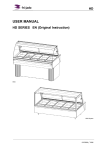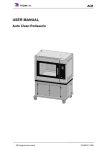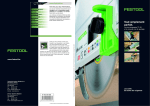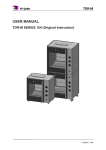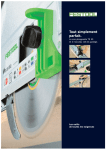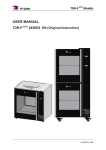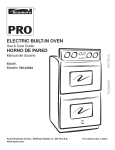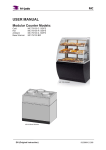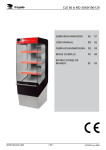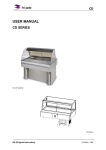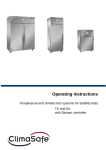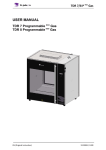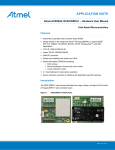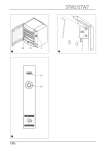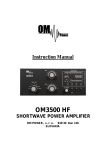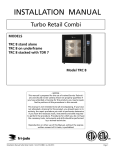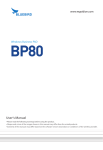Download TRC USER MANUAL - Fri-Jado
Transcript
TRC USER MANUAL TRC SERIES EN (Original Instruction) 9123829 / 1205 TRC KEEP THIS USER MANUAL FOR FUTURE USE © 2011 Fri-Jado BV, Etten-Leur, The Netherlands. We advise you to contact your supplier for the guarantee period and conditions. Further we refer to our General Terms and Conditions for Sales and Delivery that are available upon request. The manufacturer does not accept any liability for damage or injury caused by failing to adhere to these regulations or by not observing the usual caution or care in actions, operation, maintenance or repair activities, even if not explicitly described in this manual. As a result of constant commitment to improvement, it may happen that your unit deviates in detail from what is described in this manual. For this reason, the given instructions are only a guideline for the installation, use, maintenance and repair of the unit referred to in this manual. This manual has been composed with the utmost care. The manufacturer shall, however, not be held responsible for any mistakes in this manual nor for any consequences thereof. The user is allowed to copy this manual for own use. Further all rights are reserved and nothing in this manual may be reproduced and/or made public in any way. Modifications: In case of unauthorised modifications in or on the unit, every liability on the part of the manufacturer becomes null and void. EN / 2-36 9123829 / 1205 TRC CONTENTS 1. 2. 3. 4. INTRODUCTION ....................................................................................................................... 5 1.1. General ............................................................................................................................ 5 1.2. Identification of the unit ................................................................................................. 5 1.3. Pictograms and symbols .................................................................................................. 5 1.4. Safety instructions ........................................................................................................... 6 1.4.1. General ........................................................................................................................ 6 1.4.2. Moving ......................................................................................................................... 6 1.4.3. Outdoor use restrictions ............................................................................................. 7 1.4.4. Hygiene ........................................................................................................................ 7 1.5. Service and technical support ......................................................................................... 7 1.6. Storage ............................................................................................................................ 7 1.7. Disposal ........................................................................................................................... 7 Description of the unit ............................................................................................................ 8 2.1. Technical description ....................................................................................................... 8 2.2. Intended use .................................................................................................................... 8 2.3. Accessories ...................................................................................................................... 8 INSTALLATION AND FIRST USE ................................................................................................ 9 3.1. Unpacking the unit .......................................................................................................... 9 3.2. Installation and positioning ........................................................................................... 11 3.3. First use ......................................................................................................................... 12 OPERATION AND USE ............................................................................................................ 14 4.1. Control panel ................................................................................................................. 14 4.2. Switching-on the unit .................................................................................................... 15 4.3. Loading the unit............................................................................................................. 15 4.3.1. Loading the unit with baking plates or GN-pans ....................................................... 15 4.3.2. Loading the unit with baking plates and GN-pans .................................................... 15 4.4. 5. The cooking process ...................................................................................................... 16 4.4.1. Temperature setting .................................................................................................. 16 4.4.2. Duration of preparing meals ..................................................................................... 16 4.5. Taking out the baking plates and GN-pans ................................................................... 16 4.6. Switching-off the unit .................................................................................................... 16 OPERATE ................................................................................................................................ 17 5.1. Starting a program......................................................................................................... 17 5.2. Pre-heating .................................................................................................................... 18 5.3. While cooking ................................................................................................................ 18 5.4. Adding extra time to the active program ...................................................................... 19 5.5. Interrupt a program....................................................................................................... 19 5.6. Set the timer (optional) ................................................................................................. 20 EN / 3-36 9123829 / 1205 TRC 5.7. Clima-Safe ...................................................................................................................... 20 5.8. Reset alarm signal ......................................................................................................... 20 5.9. Power down .................................................................................................................. 20 6. SETTINGS ............................................................................................................................... 21 6.1. General .......................................................................................................................... 21 6.2. Information.................................................................................................................... 21 6.2.1. Access ........................................................................................................................ 21 6.2.2. Overview.................................................................................................................... 21 6.3. 6.3.1. Access ........................................................................................................................ 22 6.3.2. Overview parameters ................................................................................................ 22 6.4. 7. Manager ........................................................................................................................ 22 Service Menu ................................................................................................................. 22 PROGRAM.............................................................................................................................. 23 7.1. General .......................................................................................................................... 23 7.2. Adding programs ........................................................................................................... 23 7.2.1. Enter the program name ........................................................................................... 23 7.2.2. Programming baking step ......................................................................................... 24 7.2.3. Keeping warm (HOLD) ............................................................................................... 25 7.2.4. Saving the program ................................................................................................... 25 7.3. Edit programs ................................................................................................................ 25 7.4. Deleting programs ......................................................................................................... 25 7.5. Testing the programs .................................................................................................... 26 7.6. Sorting programs ........................................................................................................... 26 8. CLEANING AND MAINTENANCE ............................................................................................ 27 8.1. Maintenance schedule .................................................................................................. 27 8.2. Manual Cleaning ............................................................................................................ 28 8.3. Cleaning with the cleaning program ............................................................................. 29 8.4. Hand shower ................................................................................................................. 30 8.5. Fan plate ........................................................................................................................ 31 9. MALFUNCTIONS AND SERVICE; WHAT TO DO ...................................................................... 32 9.1. Replacing the mains cord .............................................................................................. 32 9.2. Replace a lamp .............................................................................................................. 33 10. TECHNICAL SPECIFICATIONS.................................................................................................. 34 11. ACCESSORIES ......................................................................................................................... 35 EN / 4-36 9123829 / 1205 TRC 1. INTRODUCTION 1.1. General This manual is intended for the user of the TRC (Turbo Retail Combi). The features and controls are being described, along with directions for the safest and most efficient use, in order to guarantee a long life of the unit. All pictograms, symbols and drawings in this manual apply to the TRC. 1.2. Identification of the unit The identification plate can be found on the outside of the machine, and contains the following data: Name of the supplier or the manufacturer Model Serial number Year of construction Voltage Frequency Power consumption 1.3. Pictograms and symbols In this manual, the following pictograms and symbols are used: WARNING Possible physical injury or serious damage to the unit, if the instructions are not carefully followed. WARNING Hazardous electrical voltage. WARNING Danger of getting injured by hot surfaces. Suggestions and recommendations to simplify indicated actions. Recycling symbol. Direction of view symbol. EN / 5-36 9123829 / 1205 TRC 1.4. Safety instructions WARNING The outside of the unit can be very hot. WARNING The maximum load on top of the unit may never exceed 50 kg. 1.4.1. General The user of the unit will be fully responsible for abiding the locally prevailing safety- rules and regulations. The unit may be operated by qualified and authorised persons only. Anyone working on or with this unit must be familiar with the contents of this manual and carefully follow all guidelines and instructions. Never change the order of the steps to be performed. The management must instruct the personnel on the basis of this manual and follow all instructions and regulations. The pictograms, labels, instructions and warning signs attached to the unit, are part of the safety measures. They may never be covered or removed, and have to be clearly visible during the entire lifetime of the unit. Immediately repair or replace damaged or illegible pictograms, warnings and instructions. For cleaning instructions, see section 8. During the grilling process, the unit can get very hot. When the door is opened the fans are stopped and the heater is de-energised. The unit must be cleaned regularly to ensure proper functioning and prevent fire hazard (over heating). Especially the backside of the fan plate. The fat collecting drawer (accessory) must be empted regularly, to prevent overflow. This appliance is not intended for the use by persons (including children) with reduced physical, sensory or mental capabilities, or lack of experience and knowledge, unless they have been given supervision or instruction concerning use of the appliance by a person responsible for their safety. Children should be supervised to ensure that they do not play with the appliance. 1.4.2. Moving When moving the unit: Before moving the unit, first switch off the mains voltage by pulling the plug from the wall socket and empty the fat collecting drawer. After that, cool-down the unit for at least ten minutes. EN / 6-36 9123829 / 1205 TRC 1.4.3. Outdoor use restrictions To avoid short-circuiting, the units may not be used outdoors unprotected. Placing under a screen is allowed. Figure 1 1.4.4. Hygiene The quality of a fresh product always depends on hygiene. Especially grilling products. With the risk of salmonella contamination – especially for chicken products – you must make sure that grilled products can never be mixed with uncooked products. Also contact between grilled products and hands or tools that have been in contact with raw chicken meat, must be avoided at all times. Hands or tools that have been in contact with raw chicken meat, must be cleaned thoroughly. 1.5. Service and technical support The electrical schematics of your unit is included. In case of malfunctions you can contact your dealer/service agent. Make sure you have the following data available: Model. Serial number. This data can be found on the identification plate. 1.6. Storage If the unit will not be used temporarily, and will be stored, follow these instructions: Clean the unit thoroughly Wrap the unit from getting dusty. Store the unit in a dry, non condensing environment. 1.7. Disposal Dispose of the machine, any components or lubricants removed from it safely in accordance with all local and national safety and environment requirements. EN / 7-36 9123829 / 1205 TRC 2. Description of the unit 2.1. Technical description The TRC uses electrical heating elements that heat up the air inside the unit. The hot air is equally divided over the interior by four fans. Hence, there is an equal temperature everywhere in the unit, and the products will be prepared nicely and equally. The intelligent control keep the temperature inside the unit fixed to level set by the operator. During the entire process, the interior of the unit will be illuminated. In order to generate steam inside the unit, pulses of water will be sprayed by the fans, and guided along the heating elements. The number of pulses and the exact moment of injection can be set by an service technician, so that there is a well defined level of humidity, during every single step of the baking process. The grids (or GN-pans) are put on guiding rails, so the unit – depending on the height of the products – can always be set to its highest efficiency. The intelligent control has a capability to store 250 different programs. Each program can consist of a preheat step, with additional (maximum 9) steps, in which the baking time, temperature, steam intensity and the “Clima Safe” can be set. Once a program is completely executed, the control can apply an “automatic baking correction” to each next run of the baking program, to get an identical baking result. Depending on the temperature flow during the baking process, the unit determines a time correction, which will be added to or subtracted from the adjusted baking time. This way an identical end result will always be guaranteed, regardless of the load of the unit, and whether the products were still frozen before the baking process or not. To prevent undesired changing, the baking programs can be protected by means of a password. The unit has a semi-automated cleaning program that cleans the unit after a cleaning agent is injected. The plating of the unit is made of stainless steel. The product contact parts are made of stainless steel AISI 304 (eventual with PTFE coating). The mains cable is provided with a plug. Communication through RS232 enables easy read-out, re-work and creating of programs via a PC. For this, special software is available at Fri-Jado Service. 2.2. Intended use The TRC has been designed for preparing and warming various sorts of vegetables and meat, and raising and baking-off bread. Any other use will not be regarded as intended use. The manufacturer accepts no liability whatsoever for loss or injury caused by failing to strictly adhere to the safety guidelines and instructions in this manual or due to carelessness during installation, use, maintenance and repair of the unit referred to in this manual and any of its Use the unit in perfect technical condition only. 2.3. Accessories Your unit contains the following standard accessories: Fat Filters (4) User manual. For optional accessories refer to section 11. EN / 8-36 9123829 / 1205 TRC 3. INSTALLATION AND FIRST USE 3.1. Unpacking the unit Your unit is shipped using a plastic cover with protecting corners, covered by a carton box. All units are placed on a wooden pallet. Around the box and pallet are two tie straps. Figure 2 Dismantling of the pallet: Before you can unpack the unit, the pallet must be taken apart. See Figure 3. 1 (8x) 3 (2x) 2 (4x) 5 (2x) 4 (2x) Figure 3 EN / 9-36 9123829 / 1205 TRC Additionally: - Remove all remaining packing materials from the unit. - Remove the protective foil from the metal parts. - Take off the standard accessories. All packing materials of this unit can be recycled. After unpacking check the state of the unit. In case of damage, store the packing material and contact the supplier within 15 days after receiving the goods. EN / 10-36 9123829 / 1205 TRC 3.2. Installation and positioning WARNING The unit must be installed by a certified electrician. 2 1 Figure 4 Positioning: The user must have sufficient freedom of movement to properly operate the unit. The ambient temperature of the unit must be between 10 and 30 °C (50 and 86 °F). Use proper lifting– and transport tools to move the unit. Place the unit, using a spirit level, flat on a solid surface. Mind the weight of the unit! The distances between the sides and other units or walls must be at least 100 mm. The minimum distance between the operator-side and possible glass panes or wooden (partition) walls must be at least 250 mm. The space between the unit and the surface it is put on, must be kept clear for proper ventilation of the electrical compartment. Keep a distance of at least 500 mm of free space above the unit. In case of a wheeled unit, the floor must be flat and levelled. The products inside the unit must be clearly visible. Keep children away from the operating side of the unit. Installation: The unit has a mains plug, and must be connected to a wall socket with the proper mains voltage. The wall socket must be mounted by a certified electrician. A water connection with an aerated valve with a ¾ inch thread connection must be available near the unit. The water pressure must be between 200 en 500 kPa (2 and 5 bar). Use connection ① for filtered water and connection ② for non filtered water (see Figure 4). Refer also to the Installation Manual. An open drainage with a diameter of at least 40 mm must be available near the unit. EN / 11-36 9123829 / 1205 TRC 3.3. First use When using the unit for the first time, clean the interior thoroughly with soap suds and heat up the unit. After commissioning discolouration of the cooking/grilling area can occur. Clean the interior ➊ ` ➋ ➌ ➍ ➎ EN / 12-36 9123829 / 1205 TRC First heat up To remove both the oil- and metal odour that will appear at first use, the unit must be heated at the maximum temperature for at least half an hour. ➊ ➋ SET 250°C ➌ ➍ SET 30-45 min. ON ➎ 250°C 1. Press ON/OFF for 3 seconds on to switch-on the unit. 2. Press OK the display the menu. 3. Create a new program containing ONE step of 250 °C (482 °F) and a duration of at least 30 minutes (see section 7). 4. Select tab “Operate” to return to the operation field. 5. Select the new program and press START/PAUSE to start (see section 4). 6. Allow the unit to fully execute the program. After the program stops, the control switches to the ‘snoozing’ mode. The unit is ready for use. EN / 13-36 9123829 / 1205 TRC 4. OPERATION AND USE 4.1. Control panel SELECTION BUTTONS DISPLAY SCREEN START PAUSE NO FUNCTION ON OK BUTTON OFF STOP ROTATION PAD (DIAL) Button SELECTION BUTTONS ON / OFF START / PAUSE STOP / CANCEL OK BUTTON ROTATION PAD CANCEL Function Selecting tabs in display screen. Switching the unit on and off. Starting and ending a program. Interrupting a program (one step back in the menu) Acknowledge a choice See "Rotation pad" Rotation pad This pad is used for: Navigating through the menu-items in the screen Changing the settings Changing the settings quickly Increase value: rub the pad clock-wise with one finger. Decrease value: rub the pad counter-clock-wise with one finger. Screen The following tabs are present: Operate “Choose between programs” Program “Creating programs” Settings “Change settings of programs” EN / 14-36 (see section 5). (see section 7). (see section 6). 9123829 / 1205 TRC 4.2. Switching-on the unit ➊ ➋ ➌ ➍ 4.3. Loading the unit WARNING To protect the operator for possible hot gases the door is equipped with a two step unlocking device. To open the door move the handle first clock-wise then counter-clockwise Opening the door will switch-off the heating to secure the safety of the operator. The baking process will resume after closing the door. When loading the unit, carefully use the available space inside the oven. The total mass of the products must be equally divided over the baking trays and plates. 4.3.1. Loading the unit with baking plates or GN-pans The oven is foreseen with two inner racks with 9 levels of supports. The GN -pans must be positioned between the two slides of a support. Grids 600x400 and GN-grids must be positioned on top of a support. Start placing GN-pans at the second support from the bottom. 4.3.2. Loading the unit with baking plates and GN-pans If you want to load the TRC using two different accessories at the same time, always fill the unit with ONE accessory fewer than the maximum allowed quantity. See to it that accessories of the same type are placed consecutively. For example: 2 baking plates + 3 GN-pans EN / 15-36 9123829 / 1205 TRC 4.4. The cooking process WARNING Do not open the door while baking. 4.4.1. Temperature setting The ideal temperature for preparing meals lies between 160 and 190 °C (320 and 374 °F). Depending on the product you can select a temperature between 0 to 250 °C (32 to 482 °F). This is the temperature in the centre of the oven. 4.4.2. Duration of preparing meals The duration depend on a number of factors: The ambient temperature and draft in the direct vicinity of the unit. Cooking temperature. The initial product temperature. The sort of meat (fat or lean) and with or without additives. The mass and shape of the product. The total amount of meat to be grilled in one grilling cycle. The end result. 4.5. Taking out the baking plates and GN-pans WARNING After baking the interior of the unit and the glass panes are very hot. Always use oven gloves when taking out the baking plates or other accessories. Use the principle as described in section 4.3 but reversed. Depending on the amount of products you have prepared, it may be necessary to empty the plates and pans before taking them out. 4.6. Switching-off the unit ➊ Press buttons together and hold for approx. 3 seconds. EN / 16-36 9123829 / 1205 TRC 5. OPERATE 5.1. Starting a program 1. Press the left-hand selection button. 2. Select the required program. The total duration of the program is shown in minutes next to the name of the program. 3. Press START/PAUSE. Use the rotation pad or arrow buttons to toggle between the programs. timer:* off * Is the timer program (see section 5.6). CLEAN refer to the automatic cleaning program (see section 8.3). EN / 17-36 9123829 / 1205 TRC 5.2. Pre-heating Only when the pre-heat function is set! The screen will display the current temperature (on the right) and the set pre-heat temperature (on the left). When the set temperature is reached, the screen will show: “Load products” and a sound is activated. 5.3. While cooking During the cooking process, the display shows a graph with the planned temperature trajectory (orange line) and the current temperature (light orange field). Under the graph, the program name and the total time is shown. In the bottom of the screen, the current temperature inside the unit and the remaining time are given. When ‘process correction’ is switched-on, the total time and remaining time will be adjusted. EN / 18-36 9123829 / 1205 TRC 5.4. Adding extra time to the active program During the process extra time can be added, by following the next steps: 1. 2. 3. 4. Press the power button. Set extra time by rubbing the rotation pad. Select the arrow point right to save setting. Press OK. The display now shows the extra time, which will be added to the last baking step. The screen always shows the total amount of extra time. 5.5. Interrupt a program Interrupt temporarily: 1. Press START/PAUSE. 2. Press START/PAUSE again to resume the program. Interrupt definitely: 1. Press STOP/CANCEL. 2. Select “yes”. 3. Press OK. EN / 19-36 9123829 / 1205 TRC 5.6. Set the timer (optional) This function allows the user to automatically start a program on a pre-determined date and time. To enable this function, the “timer function” in the Manager menu must be set to “YES”. 1. Select the recipe “timer:*off*. 2. Press OK. 3. Use the arrows to change the setting “timer function” from “off” to “on”. 4. Press OK. 5. Use the arrows to select the desired program, and press OK. 6. Select “Set time” and press OK. 7. Set the desired start time using the rotation pad. By pressing OK you switch form hours to minutes, and consequently to “save”. Press OK to save the time setting. 8. Select “Set date”. 9. Select the desired date using the right and left arrow. 10. Select “store” to save the timer settings, and to quit the menu. 11. Once the timer has been set, the top-left of the display will show a flashing clock-sign. 5.7. Clima-Safe After the cooking process the interior of the TRC will be very hot. To prevent the operator from getting exposed to the dangerous steam when opening the door, the TRC has a “ClimaSafe” function. This function blows cool air through the interior of the unit, in order to dispose of the hot air. Another advantage of the Clima Safe is the possibility of removing superfluous damp. Time intervals between 0.5 to 9.5 minutes can be set. The Pulse duration is set to 10 seconds (this can only be changed by a service technician). 5.8. Reset alarm signal When an alarm signal has been set, it will sound. To stop this signal, press OK. 5.9. Power down If no program is active and no key is touched within the next 60 minutes the unit will switchoff automatically. Press ON/OFF for some seconds to re-start the TRC. This option can be both switched-off or adjusted by a service engineer. EN / 20-36 9123829 / 1205 TRC 6. SETTINGS 6.1. General The settings of the unit can be changed by using the control panel. There are three kinds of settings: 6.2. Information Manager Service Information 6.2.1. Access 1. Activate the settings menu (right selection button). 2. Select “information”. 3. Press OK. 6.2.2. Overview The screen shows, for a predefined time, an overview with some pre-programmed settings. Pressing any knob to return to the setting menu instantaneously. EN / 21-36 9123829 / 1205 TRC 6.3. Manager The Manager menu is used to set the parameters. 6.3.1. Access 1. Activate the settings menu (right selection button). 2. Select “manager”. 3. Press OK. When a pin code has been set: 1. Use the rotation pad to enter the pin code. 2. Press OK or the right arrow to enter the next number. 3. Press OK twice. 6.3.2. Overview parameters Setting Change pin code Light Temperature Set time Set date Set contrast Time format Date format Alarm signal Pre heat mode Pre heat delta Timer function Buzzer set Key beep Water capacity Lime filter Lime filter replaced 6.4. Function and values Setting the pin code for access to the Manager Menu. This pin code can also be used for access to the Program Menu. 0000 – 9999 ON – OFF °C – °F Setting the current time Setting the current date Setting the contrast of the screen 24h – AM/PM D/M/Y – M/D/Y YES – NO NO: never a pre heating 1X: pre heating ONCE, after switching on the unit. YES: always pre heating Correction on the pre-heat temperature based upon the operation temperature.. -50°C(-90°F) – +50°C(+90°F) NO – YES Beep 1 – 5 ON – OFF 50 – 30000 The displayed value shows the remaining capacity of the lime filter in percents. reset the lime indicator back to 100% Service Menu The service menu contains settings for the language and security of the unit. This can only be accessed by the supplier or a service technician. EN / 22-36 9123829 / 1205 TRC 7. PROGRAM 7.1. General Your dealer has programs that are loaded into the unit by means of a computer. These programs vary with the composition of the product and the customer’s desire, and are customer dependent. You can protect the cooking programs and the ‘secured settings’ by changing pin code “0000” in the menu, into any other pin code. By changing the pin code back into “0000”, the protection is removed. The program menu is used to store programs yourself. A program can have not more than 9 steps. In each step both the temperature and time can be set. The memory can handle 250 programs. Access: Activate the program menu (middle selection button). If a pin code has been set: 1. Use the rotation pad to enter the pin code. 2. Press OK or the right arrow to enter the next number. 3. Press OK twice. 4. Select the desired action. 7.2. Adding programs 1. Select “add program”. 2. Press OK. 7.2.1. Enter the program name 1. Enter the first character by using the rotation pad. The name can consist of: letters: “A – Z”. numbers ”0 – 9”. and character “-“ or “blank”. The combination is free to choose. A name cannot have more than 11 characters, including blanks. You can create a blank by skipping a position. This can be done by pressing the right arrow. 2. Press OK or the right arrow to go to the next position. 3. Repeat steps 1 and 2 for the letter/number of the name, if needed. 4. Select the next position with the right arrow. 5. Press OK twice to store the name and to proceed. 6. Select “next”. 7. Press OK. EN / 23-36 9123829 / 1205 TRC 7.2.2. Programming baking step The table on the screen contains the following columns: Probe temperature Time duration Temperature Clima safe Steam intensity Row 1 shows step 1, row 2 shows step 2, etc. There can be no more than 9 steps. A selected cell shows an orange frame. To alter a cell, it needs to be ‘opened’ by selecting it and pressing OK. I. Setting the probe temperature (Option 1) 1. Select the probe temperature of the first baking step. This is the value in the top-left of the table. 2. Press OK to open the cell. The cell background turns orange. 3. Set the temperature (0 – 97 °C (32 – 206 °F)) using the rotation pad. 4. Press OK to close the cell. II. Setting the time duration (Option 2) 1. Use the right arrow to select the cell in the second column. 2. Press OK to open the cell. 3. Set the time duration of the step to (1-240 minutes) using the rotation pad. 4. Choose “- “ to skip the step. 5. Press OK to close the cell and save the settings. The first baking step can be set as the pre-heat step. Skip the time setting or enter “-“. III. Setting the temperature 5. Use the right arrow to select the cell in the third column. 6. Press OK to open the cell. 7. Set the temperature using the rotation pad. 8. Press OK to close the cell. IV. Setting the “Clima Safe” (0.5… 9.5) 1. Use the right arrow to select the cell in the fourth column. 2. Set the time interval using the rotation pad. 3. Press OK to close the cell. V. Setting the amount of steam 1. Use the right arrow to select the cell in the fifth column. 2. Press OK to open the cell. 3. Select the steam program (0, 1, 2 or 3 stars): no steam * minimum amount of steam ** medium amount of steam (temp. Limited to 150 °C (302 °F)). *** maximum amount of steam (temp. Limited to 130 °C (266 °F)). 4. Press OK to close the cell. The exact quantity of steam can only be adjusted in the service menu. VI. Next cooking step Select the first cell of the next cooking step, and repeat steps I - V to add another cooking step. EN / 24-36 9123829 / 1205 TRC 7.2.3. Keeping warm (HOLD) Steps 2 - 9 can be set to keep the products warm. Skip setting the time duration, or enter “-“. If setting the temperature, the time duration will automatically be set to HOLD. A “keeping warm” step will only be executed if this is the last program step. A “keeping warm” step lasts infinitely and it keeps the unit at the desired temperature. The temperature must be set on at least 85°C (185°F). 7.2.4. Saving the program 1. Select “saving program”. 2. Press OK. 7.3. 1. 2. 3. 4. Edit programs Select “Edit program”. Press OK. Select the required program. Press OK. Edit the program name 1. Select the position of the character. 2. Change the character using the rotation pad. 3. Use a ‘blank’ to erase a character. 4. Repeat steps 1 and 2 if needed. 5. Select next. 6. Press OK. Edit the baking steps 1. Select the cell. 2. Press OK. The cell background turns orange. 3. Set the value using the rotation pad. 4. Press OK to close the cell. 5. Repeat steps 1 - 4 if needed. 6. Select “save program”. 7. Press OK. 7.4. Deleting programs Deleting of a program cannot be undone. 1. 2. 3. 4. 5. Select “delete program”. Press OK. Select the program. Press OK. Check whether the program name matches the program you wish to delete. 6. Select “yes” if this is the case. Select “no” if not. 7. Press OK. EN / 25-36 9123829 / 1205 TRC 7.5. Testing the programs In the test-mode the program will run normally, but the settings can be changed during the process. Changes that are made (during testing) in the steps that already are passed, will not affect the products in the unit. However, the changes will be stored and will be active the next time the program is executed. The changes that are made, will be stored during the test-mode. 1. Select “test program”. 2. Press OK. 3. Select the program. 4. Press START/PAUSE or OK. The process will be running identically to the normal execution of a cooking program. During the process the program can be changed. 1. 2. 3. 4. Press OK Apply the changes. Select “save program”. Press OK 7.6. Sorting programs This function allows you to sort programs alphabetically. 1. 2. 3. 4. Select “sorting alphabetically”. Press OK Use arrows to select “YES”. Press OK. EN / 26-36 9123829 / 1205 TRC 8. CLEANING AND MAINTENANCE WARNING Do not use aggressive or abrasive materials. These will damage the surface which will make it more difficult to remove dirt. Clean the inside, the removable parts and the accessories thoroughly with cleanser and water before putting the unit into use. Follow the cleaning instructions as described in this chapter. Treat the outer surface of the interior window with a soft cleaning agent to protect the reflection layer. 8.1. Maintenance schedule Item Interior Exterior Cooking area Glass panes Drip tray Drain Fan blade Action Clean the interior, see section 8.2. Clean the exterior using little water, cleaning agent, a soft brush or a sponge. Dry the exterior with a cloth. Use Stainless Steel cleaning spray to remove stains, and restoring the gloss. Pay attention to proper distribution of items inside the oven. Put back all accessories. Open the outer door Open the inner door Clean the glass panes with warm soapy water or grill cleaner. Flush the drip trays located under the inner glass and the rubber with hot water. This to prevent obstruction in the drain and drip trays. Clean the drain with a drill brush. Remove the fan plate (see section 8.5). Clean the fan blade with a cloth and cleaning agent. Replace the fan plate and grids. EN / 27-36 Frequency Daily Weekly Weekly Weekly Weekly Monthly Monthly 9123829 / 1205 TRC 8.2. Manual Cleaning The unit can best be cleaned when it is still lukewarm. In this condition, grilling remains and fat can easily be removed. The best cleaning results can be achieved by using special oven- and grill cleaners that can be obtained in retail. For hygiene matters and optimum state of your TRC, it is advised to maintain a fixed daily cleaning schedule. ➊ ➋ ➌ ➍ PRESS BUTTONS TOGETHER AND HOLD ± 50°C ➎ ❻ 1. Baking plates, GN-pans, insert trays and grids must be removed before cleaning the unit 2. De mount the back panel (Fan plate). Refer to section 8.5. 3. Manually clean the interior and the windows using soapy water. The soapy water will run down the drainage. 4. Clean the accessories. 5. Rinse with clean water to remove all suds. 6. Rub the cleaned parts with a cloth to remove cleansing remains, and to dry the unit. 7. Mount the back panel. Make sure that the two guiding pins at the bottom of the oven interior meet the holes in the bottom edge of the back panel. EN / 28-36 9123829 / 1205 TRC 8.3. Cleaning with the cleaning program WARNING Make sure the unit is attached to a water supply system. After cleaning, the inner glass pane must be thoroughly flushed with water, because of the remaining chemicals of the cleaning program 1. 2. 3. 4. 5. Remove pans and grids. Switch on the unit and select “Operate”. Select the cleaning program. Press OK. The unit will either heat-up or cool-down to 60°C (140 °F). 6. Wait for the notification “add cleaning agent” 7. Open the door manually, and spray the entire interior excessively with cleaning agent. 8. Close the door. 9. Press START. The unit will now clean itself (the cleaning program takes about 120 minutes). 10. Use the manual flush when the unit indicates this. Refer to section 8.4. After finishing the program, the unit switches off automatically EN / 29-36 9123829 / 1205 TRC 8.4. Hand shower After the cleaning program is finished, the hand shower can be used to remove both bakeand cooking remains. 1. Pull the hose out of the unit. The hose is foreseen of a rattle mechanism. The effective length of the hose is about 5 feet. 2. After using the shower, pull the hose until the rattle stops. Now release the hose GENTLY to guide it back into the unit. Direction of water Press the lever to spray EN / 30-36 9123829 / 1205 TRC 8.5. Fan plate The fan plate with (4) grids and filters in the back of the TRC needs to be cleaned at least once a day, and, depending on the pollution, even more often. This way you can be sure that the ventilation will be optimal. If this is not done as instructed, the baking time will increase and the unit can get overheated. Remove: The plate can be detached without using tools (see Figure 5). Lift the plate somewhat and pull. After taking off, the plate can be cleaned. Remount: When placing the plate make sure that the two guiding pins at the bottom of the oven interior meet the holes in the bottom edge of the back panel Figure 5 EN / 31-36 9123829 / 1205 TRC 9. MALFUNCTIONS AND SERVICE; WHAT TO DO Before you contact your supplier/dealer in case of a malfunction, there are some items you can check yourself: Is the power supply working properly? Check fuses and differential switch. Has the timer clock been properly set? Item Control Malfunction Program do not start Fan ONE fan not spinning Fan Fan ALL fans not spinning Noisy fan Oven Product is not getting done equally Oven The oven does not heat up Steaming No steam injection 9.1. Possible action Check if the door is closed correctly. Remove the plug from the socket. Open the door. Remove fan plate (see section 8.5) and check what's blocking the fan blade. Open and close door Fan polluted, clean (see section 8.5). Try a lower cooking temperature. Check fuses and/or the differential switch. Open and close door. Check fuses and/or the differential switch in the electricity board. Check water supply. Replacing the mains cord WARNING Hazardous electrical voltage. If the mains cord is damaged, it must be replaced by the manufacturer, his service agent or a similarly qualified person in order to avoid hazards. EN / 32-36 9123829 / 1205 TRC 9.2. Replace a lamp WARNING Remove the power plug from the wall socket. WARNING Do not touch the lamps with bare hands. Use a clean cloth or paper tissues when replacing the lamp. Remove any moisture with alcohol or methyl spirits after the lamp has cooled down ➊ ➋ Press buttons and hold for approx. 3 seconds ➌ Open the outer door and the inner door. THREE LAMPS RIGHT TWO LAMPS LEFT ➍ See the instructions that are packed with the lamps. EN / 33-36 9123829 / 1205 TRC 10. TECHNICAL SPECIFICATIONS WARNING Consult the identification plate to get the proper specifications of the unit. The electrical data may vary from country to country. European Models Model Dimensions - Width - Depth - Height Weight - Gross - Nett Maximum ambient temperature Sound pressure Water connection, aerated Water pressure Drain, open connection Electrical installation - Voltage - Frequency - Connected Power - Max. nominal current - Plug1 - Cable length approx. TRC8 TDR8-TRC8 995 mm 792 mm 1125 mm 995 mm 830 mm 2125 mm 207 kg 176 kg 35 °C < 70 dB (A) ¾” 200 – 500 kPa min. 40 mm 410 kg 349 kg 35 °C < 70 dB (A) ¾” 200 – 500 kPa min. 40 mm 3N~ 400/230 V 50...60 Hz 11 kW 16 A CEE-form 16A 2.2 m 3N~ 400/230 V 50...60 Hz 21 kW 32 A CEE-form 32A 2.2 m TRC8 TDR7-TRC8 995 mm 792 mm 1125 mm 995 mm 830 mm 2125 mm 207 kg 176 kg 35 °C < 70 dB (A) ¾” 200 – 500 kPa min. 40 mm 410 kg 349 kg 35 °C < 70 dB (A) ¾” 200 – 500 kPa min. 40 mm 3~ 208 V 50...60 Hz 11 kW 32 A NEMA 15-50P 1.9 m 3~ 208 V 50...60 Hz 11 / 10.5 kW 32 A / 30.8 A 2x NEMA 15-50P 1.9 m American Models Model Dimensions - Width - Depth - Height Weight - Gross - Nett Maximum ambient temperature Sound pressure Water connection, aerated Water pressure Drain, open connection Electrical installation - Voltage - Frequency - Connected Power - Max. nominal current - Plug2 - Cable length approx. 1 2 Depending on Country Depending on Country EN / 34-36 9123829 / 1205 TRC 11. ACCESSORIES For the TRC the following accessories are available: Standard wheeled under frame GN-pan GN-pan perforated GN-grid Grid 400 x 600 Baking plate 400 x 600 Oven gloves Oven gloves (long) Fat filters Fat tray with valve EN / 35-36 9123829 / 1205 TRC Fri-Jado BV Oude Kerkstraat 2 4878 AA Etten-Leur The Netherlands Tel: +31 (0) 76 50 85 400 Fax: +31 (0) 76 50 85 444 EN / 36-36 9123829 / 1205




































